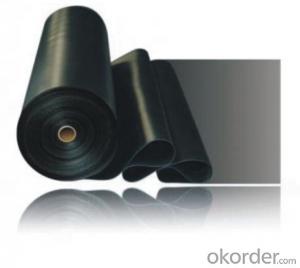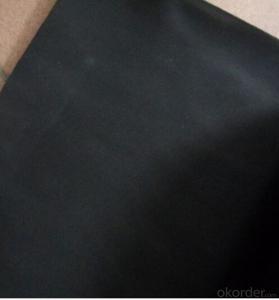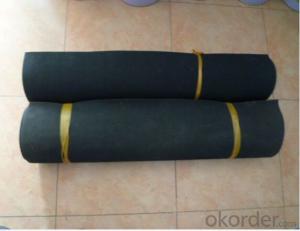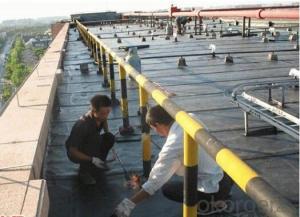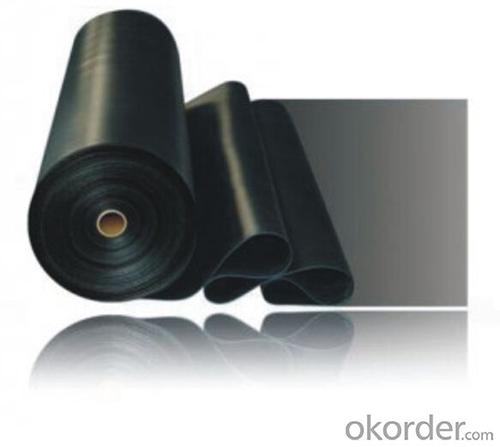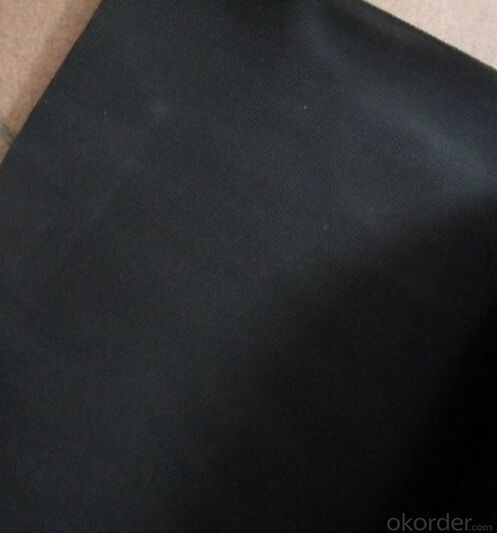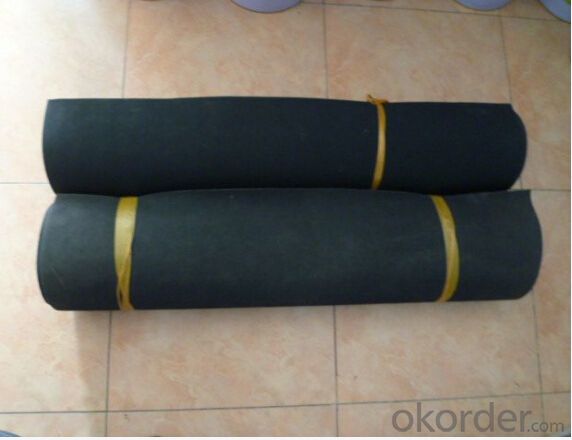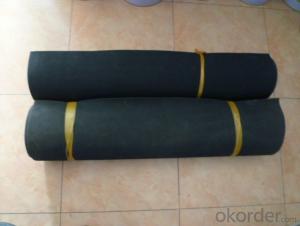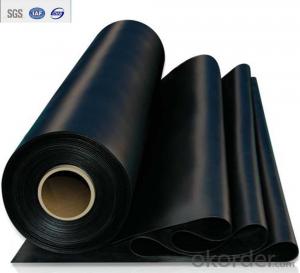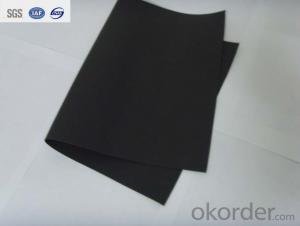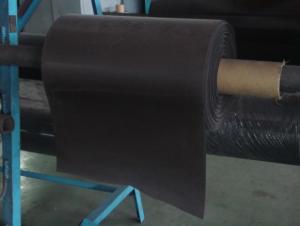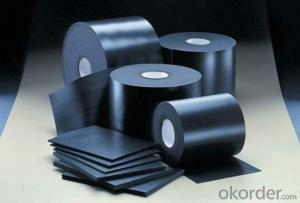Width 2m EPDM Waterproofing Membrane for Roof Use
- Loading Port:
- Qingdao
- Payment Terms:
- TT OR LC
- Min Order Qty:
- 2000 m²
- Supply Capability:
- 100000 m²/month
OKorder Service Pledge
OKorder Financial Service
You Might Also Like
EPDM waterproofing Rubber membrane
1. Product Description of EPDM Waterproofing Membrane:
EPDM Waterproofing Membrane is the modified materials which is widely used at home and abroad in the kinds of roofs, tunnel, basement such sorts of constructions' waterproofing.
They are based upon EPDM rubber with modifier, softener and accelerant assistants added to provide flexibility and stability . Through the precise ingredients, mixing, extrusion, rolling, curing processes to made of modified EPDM Waterproofing material with high strength and high flexibility.
2. Product Features of EPDM Waterproofing Membrane:
1). Great tensile strength,long-range elasticity and aging resistant.
2). Excellent heat reisistant and can be used under -70°C~~+110°C .
3).Good anti-corrosion, ultraviolet resistant, root penetration resistance
4).Long life use over 50 years and used longer 100 years or more under the condition of buried in the ground.
5).Light and easy to install.
3. Product Sepcification of EPDM Waterproofing Membrane:
Thickness : 0.3-2.0mm
Width :1-4m
Length: 15-50m/roll
Item | value | ||
JL1 | JF1 | ||
Tensile Strength (Mpa) | normal tamperature | 7.5 | 4.0 |
60°C ≥ | 2.3 | 0.8 | |
Elongation at break (%) | normal tamperature ≥ | 450 | 450 |
-20°C ≥ | 200 | 200 | |
Tear Resistance (N) | ≥ | 25 | 18 |
Water impermeability | 30mm | 0.3Mpa | 0.3Mpa |
Cold bending | (°C) ≤ | -40 | -30 |
Heating Shrinking rate | extand < | 2 | 2 |
shrink < | 4 | 4 | |
4.Product Application of EPDM Waterproofing Membrane:
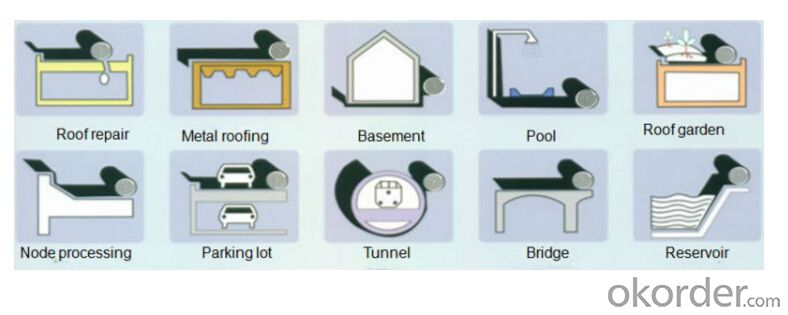
4. Some photos:
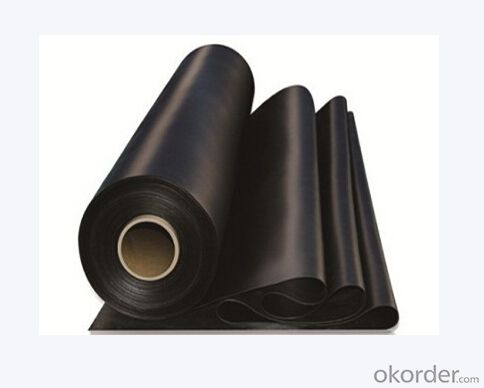
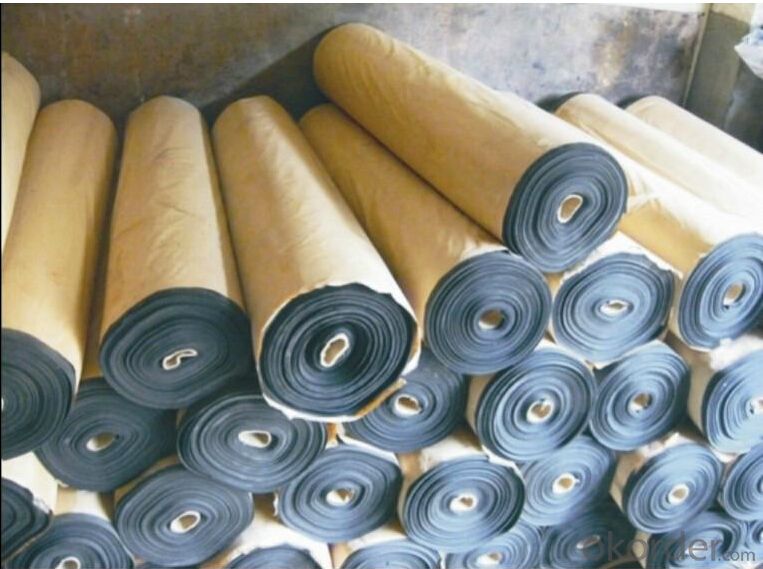
- Q: Can a waterproofing membrane be used in areas with high humidity?
- Yes, a waterproofing membrane can be used in areas with high humidity. The membrane is designed to prevent water penetration, including moisture from high humidity levels. It acts as a barrier, protecting the underlying surfaces from water damage, mold, and mildew.
- Q: Can a waterproofing membrane be used on roofs with rooftop gardens?
- Yes, a waterproofing membrane can be used on roofs with rooftop gardens. The membrane serves as a protective layer that prevents water from seeping into the underlying structure, ensuring that the rooftop garden remains dry and well-maintained.
- Q: Can a waterproofing membrane be used on precast brass surfaces?
- Yes, a waterproofing membrane can be used on precast brass surfaces. Waterproofing membranes are designed to provide a protective barrier against water infiltration, and they can be applied to a variety of surfaces including concrete, metal, and precast materials. In the case of precast brass surfaces, the membrane can help prevent water penetration, which is particularly important in areas exposed to moisture such as bathrooms, kitchens, or outdoor environments. By applying a waterproofing membrane, the precast brass surface can be effectively protected from water damage, corrosion, and potential deterioration, ensuring its longevity and preserving its aesthetic appearance.
- Q: Can a waterproofing membrane be applied on top of existing surfaces?
- Yes, a waterproofing membrane can be applied on top of existing surfaces. However, it is important to ensure that the existing surface is clean, dry, and free from any contaminants or loose materials before applying the membrane. Additionally, proper surface preparation and application techniques should be followed to ensure the effectiveness and longevity of the waterproofing system.
- Q: Can a waterproofing membrane be applied on top of insulation materials?
- Yes, a waterproofing membrane can be applied on top of insulation materials. However, it is important to ensure that the insulation material is properly installed and does not compromise the effectiveness of the waterproofing system. Additionally, the type of insulation material used should be compatible with the waterproofing membrane to avoid any potential issues or damage.
- Q: Can a waterproofing membrane be used for an underground structure?
- Yes, a waterproofing membrane can be used for an underground structure. Waterproofing membranes are designed to provide a protective barrier against water infiltration, making them suitable for preventing moisture buildup and potential damage in underground structures such as basements, tunnels, or subways.
- Q: Can a waterproofing membrane be used in ponds or reservoirs?
- Ponds and reservoirs can benefit from the use of a waterproofing membrane. These membranes are specifically designed to create a barrier against water, effectively preventing leaks and seepage. They are commonly employed in various water containment applications, including ponds, reservoirs, and other water storage structures. Waterproofing membranes are typically constructed from durable materials such as rubber, PVC, or HDPE (high-density polyethylene). These materials exhibit resistance to UV radiation, chemicals, and other environmental factors that could compromise the membrane's integrity. As a result, they provide long-lasting protection, effectively preventing water from penetrating the structure. The installation process for a waterproofing membrane in a pond or reservoir involves careful surface preparation, followed by the application of the membrane using suitable adhesives or welding techniques. The membrane is typically applied to the entire surface area, including the walls and base of the structure, ensuring complete water tightness. The utilization of a waterproofing membrane in ponds or reservoirs offers several benefits. It helps to maintain the water level by preventing evaporation and leakage, which is particularly crucial in arid regions where water scarcity is a concern. Additionally, it safeguards the surrounding soil from water contamination and prevents the loss of valuable water resources. However, it is essential to note that the selection of the appropriate waterproofing membrane should be based on the specific requirements of the pond or reservoir. Factors such as the structure's size, the type of water it will hold, and the environmental conditions should be taken into consideration when choosing the most suitable membrane. In conclusion, a waterproofing membrane is a reliable and long-lasting solution for water containment and prevention of leaks in ponds or reservoirs. By ensuring proper installation and maintenance, it can guarantee the integrity and sustainability of the water storage structure.
- Q: How does a waterproofing membrane handle extreme temperature fluctuations?
- A waterproofing membrane is designed to handle extreme temperature fluctuations by being resistant to temperature changes. It is typically made from materials that have a high tolerance for both hot and cold temperatures. These materials are chosen for their ability to expand and contract without losing their integrity or effectiveness. During hot weather, the waterproofing membrane will expand slightly to accommodate the increase in temperature. This expansion helps to prevent any cracks or gaps from forming that could allow water to penetrate the membrane. Similarly, during cold weather, the membrane will contract to avoid any damage caused by freezing temperatures. The ability of a waterproofing membrane to handle extreme temperature fluctuations is also achieved through its installation process. The membrane is typically applied in multiple layers, creating a seamless and flexible barrier. This layered application allows the membrane to withstand the stresses caused by temperature changes without compromising its protective properties. Additionally, some waterproofing membranes are equipped with special additives or reinforcements that enhance their ability to handle extreme temperature fluctuations. These additives can provide additional strength and flexibility, ensuring that the membrane remains intact and functional even in the face of severe temperature changes. Overall, a properly installed and maintained waterproofing membrane is designed to handle extreme temperature fluctuations by expanding and contracting, maintaining its integrity, and providing a consistent barrier against water intrusion.
- Q: Can a waterproofing membrane be installed in areas with high humidity?
- Installing a waterproofing membrane is possible in areas with high humidity. In fact, high humidity can contribute to the necessity of waterproofing due to the possibility of moisture accumulation and potential water damage. Regardless of the humidity levels, waterproofing membranes are designed to establish a barrier against water infiltration. Nonetheless, it is crucial to guarantee the correct installation and sealing of the membrane to prevent any moisture seepage. Moreover, in areas with high humidity, it might be essential to adopt additional measures like utilizing moisture barriers or dehumidifiers to provide further protection against potential water damage.
- Q: Are there any environmental considerations when using a waterproofing membrane?
- Yes, there are several environmental considerations when using a waterproofing membrane. One of the main concerns is the potential for harmful chemicals or materials to be used in the production of the membrane. Some waterproofing membranes may contain toxic substances such as volatile organic compounds (VOCs) or heavy metals, which can have detrimental effects on human health and the environment. Another consideration is the disposal of the membrane once it reaches the end of its life cycle. Many waterproofing membranes are not biodegradable and can contribute to landfill waste. Improper disposal can lead to environmental pollution and harm to ecosystems. Additionally, the production of waterproofing membranes often requires energy-intensive processes and the extraction of non-renewable resources. This can contribute to greenhouse gas emissions and the depletion of natural resources. To mitigate these environmental concerns, it is important to choose waterproofing membranes that have been manufactured using eco-friendly materials and processes. Look for products that are labeled as low VOC or free from hazardous substances. Additionally, consider using membranes that are recyclable or made from recycled materials to reduce waste generation. Proper disposal of the membrane at the end of its life cycle is also crucial, and options such as recycling or repurposing should be explored. Overall, it is essential to consider the environmental impact of waterproofing membranes and choose products and practices that minimize harm to the environment and promote sustainability.
Send your message to us
Width 2m EPDM Waterproofing Membrane for Roof Use
- Loading Port:
- Qingdao
- Payment Terms:
- TT OR LC
- Min Order Qty:
- 2000 m²
- Supply Capability:
- 100000 m²/month
OKorder Service Pledge
OKorder Financial Service
Similar products
Hot products
Hot Searches
Related keywords
